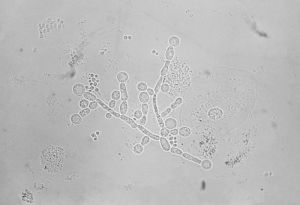EMBO Mol Med 2018; e8485; DOI 10.15252/emmm.201708485
Alsina‐Beauchamp D, Escós A, Fajardo P, González‐Romero D, E Díaz‐Mora, Risco A, Martín‐Serrano MA, del Fresno C, Dominguez‐Andrés J, Aparicio N, Zur R, Shpiro N, Brown GD, Ardavín C, Netea MG, Alemany S, Sanz‐Ezquerro JJ, Cuenda A.
PLoS Pathog. 2017 Sep 18;13(9):e1006632. doi: 10.1371/journal.ppat.1006632
Domínguez-Andrés J, Arts RJW, Ter Horst R, Gresnigt MS, Smeekens SP, Ratter JM, Lachmandas E, Boutens L, van de Veerdonk FL, Joosten LAB, Notebaart RA, Ardavín C, Netea MG.
Galán-Díez M, Arana DM, Serrano-Gómez D, Kremer L, Casasnovas JM, Ortega M, Cuesta-Domínguez A, Corbí AL, Pla J, & Fernández-Ruiz E
Innate immunity to Candida albicans depends upon recognition of molecular patterns on the fungal cell-wall. However, masking of major components such as beta-glucan seems to be a mechanism that fungi have evolved to avoid immune-cell recognition through Dectin-1-receptor. Although the role of C. albicans mitogen-activated protein kinase (MAPK) pathways as virulence determinants has been previously established in animal models, the mechanism involved in this behavior is largely unknown. In this study we demonstrate that disruption of the C. albicans ERK-like-1 (CEK1)-mediated MAPK pathway causes enhanced cell-wall beta-glucan exposure triggering immune responses more efficiently than wild-type yeast, as measured by Dectin-1-mediated specific binding, human dendritic cell (hDC)- and macrophage-mediated phagocytosis, killing and activation of intracellular signaling-pathways. At the molecular level, disruption of CEK1 resulted in altered spleen tyrosine kinase (Syk)-, Raf-1- and ERK1/2- activation together with I-kappaB degradation on hDC and increased Dectin-1-dependent AP-1 activation on transfected cells. In addition, concurring with these altered pathways, we detected increased reactive oxygen species production and cytokine secretion. In conclusion, the CEK1-mediated MAPK pathway is involved in beta-glucan exposure in a fungal pathogen, hence influencing Dectin-1-dependent immune-cell recognition, thus establishing this fungal intracellular signaling route as a promising novel therapeutic target.

